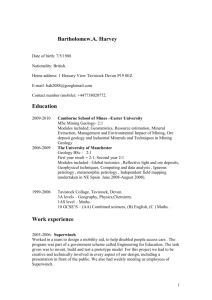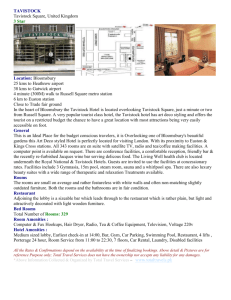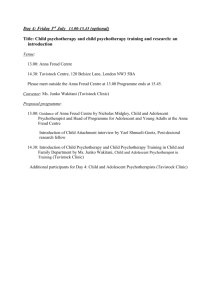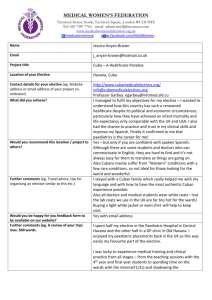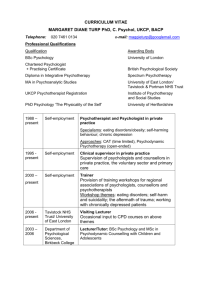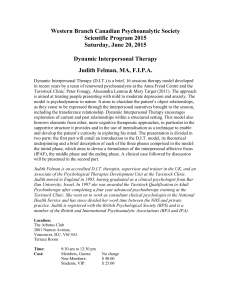Tavistock & District LEB: food - Dartmoor Forest Parish Council
advertisement
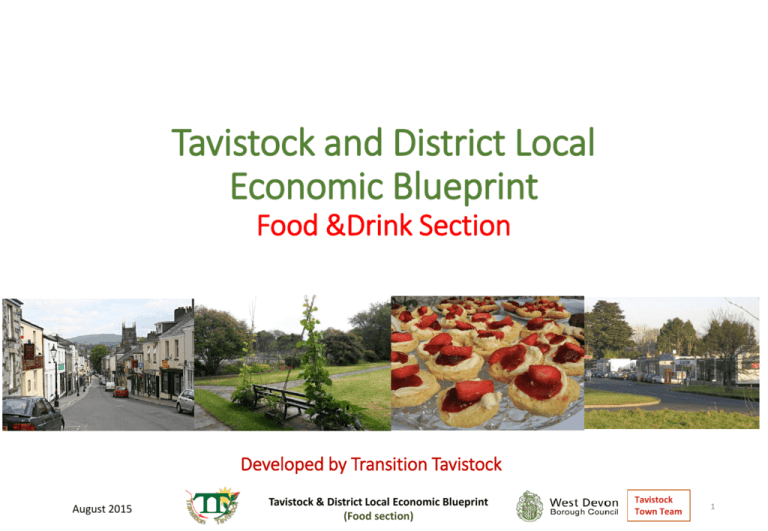
Tavistock and District Local Economic Blueprint Food &Drink Section Developed by Transition Tavistock August 2015 Tavistock & District Local Economic Blueprint (Food section) Tavistock Town Team 1 Executive Summary / 1 Our patterns of spending on food and energy have a significant impact on our local economy. The Tavistock and District Local Economic Blueprint evaluates how much is spent in these sectors, how much benefit this brings to the local economy, and what steps might be needed in order to achieve increasing proportions of our needs through local supply chains. The project was led by Transition Tavistock, www.transitiontavistock.org.uk with support from local public, business and community stakeholders. This section covers food and drink and is released ahead of the main report, due to be launched later in 2015. The focus is on Tavistock and nearby (“Southern Link”) parishes: about 32,000 of us live in this area. Our vision Recommendations for getting there Collaborate for a better local food economy A growing proportion of food and drink bought and served in the Tavistock area is produced locally, with the area known for attractive, affordable local produce. Enable growth through public policy Encourage demand for local food Reduce barriers to buying local food Help businesses grow and collaborate Facilitate home and community growing August 2015 Tavistock & District Local Economic Blueprint: food section 2 Executive Summary / 2 Headline findings Food choices affect our health, environment and economy. Despite our heritage as a food producing area we now get most of our food from large companies with national and international rather than regional or local supply chains. Food remains a significant part of our economy, with 2/3 of our land used for agriculture – mainly livestock – and hundreds of food businesses, from farms to restaurants, providing around 3000 local jobs. Over £80m a year is spent on food and drink by people living in or visiting the area. There is no direct measure of how much of this (is in any sense) locally produced. It seems likely that only a small amount is even from Devon or Cornwall. A marginal shift in the overall pattern could therefore retain significant funds in the local economy. £47m is spent on shopping for home consumption, mainly through a few supermarkets. Shoppers take some interest in the origin of food, but prioritise price and convenience. “Local origin” is attractive but undefined, with interpretation varying by person and product. Eating and drinking outside the home is a significant aspect of the local food economy. We estimate that it accounts for a further £35m of resident and tourist spend, spanning a wide range of outlets. Local sourcing often an explicit part of the cultural or quality offer. A number of independent businesses and public bodies source food locally as a matter of policy when they can get reliable supply and consistent quality. Supermarkets do not appear to source from local food producers to any significant extent. August 2015 Tavistock & District Local Economic Blueprint: food section 3 Contents Executive summary Brief introduction to overall project Food and drink Concept and scope Approach and outcomes Stakeholders Introduction to food and drink section 2 5 6 7 8 A vision for our food economy What it could look like in future Why it matters Meaning of “local” 9 10 12 The current picture in Tavistock and district: Growing food Working with food Shopping Eating out 13 17 20 24 Scope for change: Consumer views Business views Challenges Recommendations and case studies References, inspiration, acknowledgements. August 2015 Tavistock & District Local Economic Blueprint (Food section) 25 27 28 29 37 Tavistock Town Team 4 Brief introduction to TAD LEB Spending on food and energy are essential to meet our everyday needs. Across Tavistock and District (TAD) this adds up to over £120m pa. Much of this is spent with large organisations based elsewhere. The question we’re asking … Do we understand what benefits this brings to our local economy and communities, and what opportunities there are for these sectors to deliver more for our future health, wellbeing, resilience and prosperity? The TAD Local Economic Blueprint (LEB) has developed an initial evidence based understanding of this, supported by recommendations for securing more local benefit. We are not producing a conventional report. We hope you enjoy this format. More detailed supporting figures are available on request. Two years work has been invested from initial idea to final report! August 2015 Source: WDBC Southern Link Parishes – pink area Geographical scope • • • Tavistock and District, for the purposes of this study, includes all West Devon Borough Council Southern Link Parishes Population: 32,200 (PPSA estimates, West Devon 2012) Households: 13,481 (2011 Census Data) Tavistock & District Local Economic Blueprint (Food Section) 5 Approach to preparing TAD LEB Transition Tavistock promoted project and secured initial funding from WDBC, Tavistock Town Team and Tamar Valley AONB Recruited local stakeholders to own project Agreed initial vision for our food and energy economy with stakeholders Recruited food and energy sector experts to support project Undertook secondary research from information available in public domain Worked with sector experts and others to gather primary research Reviewed findings with stakeholders and sector experts Developed analysis and findings and prepared report Now – sharing findings and developing actionable plan for next 3 years. August 2015 Tavistock & District Local Economic Blueprint (Food Section) 6 TAD LEB Stakeholders We are grateful to all who have contributed time and ideas to this project. Stakeholders include: Devon County Council West Devon Borough Council Tamar Grow Local and Tamar Valley Food Hubs Tavistock Town Council Buckland Monachorum, Bere Ferrers and Dartmoor Forest Parish Councils Dartmoor National Park Authority Tavistock Chamber of Commerce Tavistock BID Tavistock Business Association Federation of Small Businesses Mount Kelly Foundation Tavistock College Institute of Sustainability Solutions Research (ISSR) at Plymouth University. August 2015 Tavistock & District Local Economic Blueprint (Food Section) 7 Food and drink: introduction We both need and enjoy food and drink*, and on average spend 1/5th of our income on them. The Tavistock area has a heritage of producing good food. About 1/4 of local jobs involve growing, making or selling it. So where does our food come from now, and where does the money go? Could we change the pattern to benefit the current and future community? This section of Transition Tavistock’s Local Economic Blueprint gives our research findings and recommendations. * In what follows “food” normally includes drinks, including alcohol, as well. August 2015 Tavistock & District Local Economic Blueprint: food section 8 A vision for our food economy A growing proportion of food and drink bought and served in the area is produced locally. Both businesses and public sector buyers seek local supplies of produce. A network of businesses co-operates to provide a diverse range of offers. Every household is able to prepare healthy meals from fresh and local ingredients; and can access land to grow their own. Our area is known for attractive, affordable local produce. There is a vibrant self-supporting network of producers, outlets and consumers from field to fork. Business support and skills training is available to those able and willing to work in the sector. Work in producing and serving good food is celebrated. But why? The quotes that follow are from national and Devon reports, from a wide range of stakeholders, setting out the rationale and benefits of rethinking our approach to food. August 2015 Tavistock & District Local Economic Blueprint (Food Section) 9 Why it matters: what others say “It is a sign of our increasing separation from nature that we are losing sight of where food comes from and how it is produced. The way we buy it adds to this alienation. …. Local food is a powerful way to form our own connections to the land, landscape and nature. It is a chance to enjoy seasonal produce, to discover the best, most wholesome and freshest food around and the most distinctive varieties and tastes. It is our chance to support a food network that is rich with variety and diversity and meaning. It Local agriculture and short food is a chance we need to seize.” (Monty Don in introduction to “From Field to Fork” [F2]) supply chains have economic, social and cultural benefits for farmers, consumers and rural areas in general. This sector increases the income of farmers and the consumption of fresh .. food, brings consumers and “If we are to seriously address the health, ecological and social imbalances the current farmers closer, .., helps to food system inflicts on us, we shall need to return to a more holistic approach to strengthen rural-urban linkages production and consumption. We already know the benefits of healthy exercise such as and .. is growing across Europe gardening brings. We experience the economic value of bringing growers and consumers to meet rising consumer together, providing greater quality and reliability. We know it makes sense not to discard demand. (EPRS [F19]) food to landfill or incineration. We welcome the opportunities for rich learning for our children to appreciate the natural cycles which come with planting and growing. We thus propose developing a Devon food strategy based on a whole systems-based approach.” (“Feeding Devon’s Future”[F3]) August 2015 Tavistock & District Local Economic Blueprint (Food Section) 10 Why it matters: what others say (contd.) “…over the past decades, there has been steady erosion in our food culture. However from field to fork, the food system remains one of the biggest employment sectors in the South West. It is also one of the greatest single contributors to long term public health outcomes, as well as to carbon emissions, biodiversity and waste; and to skills development, community cohesion and resilience.” (“The Future of Food in Plymouth”[F4]) “A sense of being interdependent is a core aspect of being human, yet we live in an age when that fact needs to be articulated afresh and made evident in the way we behave.” (Rt Revd. Tim Thornton in introduction to “Feeding Britain” [F5]) “We need an approach to food and farming policy that provides resilient, vibrant and sustainable rural and urban development. We need an approach that will halt and reverse the decline in all the things that British people love about our countryside: diverse and plentiful wildlife; a varied landscape; farm animals enjoying life out of doors; and fresh, seasonal, local food which can be bought at fair and reasonable prices from the people who produce it. We need an approach that will address the crisis of diet-related obesity and ill health, including for those on low income, and that will safeguard the basis of future food supplies for everyone. (“Square Meal” [F6]) “ August 2015 Tavistock & District Local Economic Blueprint (Food Section) “Ever growing pressures on the global food system mean that it will make even more economic and environmental sense to make the most of our own food producing resources in the future..” (“Backing the Business of Britain’s Farming” [F9]) 11 But what is “local”? There is no agreed definition of “local food”. X It is not defined by any regulator or national branding scheme. Government policy & national stakeholders (eg NFU) focus on increasing the proportion of food sourced from Britain as a whole. Nor does this blueprint impose a definition. Rather, we see value in moving to a “more local” economy along a continuum. Academics, suppliers and campaigners use a range of definitions, eg. CPRE Food Webs [F2] focused on a 30 mile radius of a town centre Food & Drink Devon expects sourcing from the county of Devon Tamar Grow Local source from the water catchment of the River Tamar where possible. Food for Life certification gives credit for food from the same region (eg South West) Consumers also vary in interpretation [F2p51]but tend to mean from the vicinity of their home or the outlet - approx 30 miles if asked about distance. [F8] And the journey can be complex, eg August 2015 Animals for meat may be bred, born, raised & finished in different places. Cakes and confectionery made locally may involve overseas ingredients eg chocolate. A Food Plymouth project distinguished locally produced, processed & distributed [F14]. We encourage business and individual consumers to make their own thoughtful choices, which may vary across the range of foods they use. Tavistock & District Local Economic Blueprint: food section 12 Tavistock is surrounded by farms Livestock predominates Two thirds of land in West Devon is farmed across 1116 agricultural holdings (Source DEFRA 2013) Sheep Poultry Grassland 35% Cereal Other arable crops South West Cattle West Devon Fruit & vegetables 55% Other farming Not agriculture Pigs 4% 0% 2% August 2015 4% 0.0 2.0 4.0 6.0 Livestock count per head of population (DEFRA 2013) Tavistock & District Local Economic Blueprint (Food Section) 13 Food production is a key income source Devon farm gate value by product 2010 Source [F11] Dairy (milk) Beef Sheep A University of Exeter report in 2012 [F11] estimated the total value to Devon of farm produce at £509m. Poultry Scaled to our study area by population this would be Horticulture £22m. Pigs Cereals not for stockfeed Potatoes Other arable crops August 2015 Tavistock & District Local Economic Blueprint (Food Section) 14 With overall growth but changing land use 100 % change 2010 to 2013 - source DEFRA 92 80 The area recorded as used for fruit and vegetables grew from 68ha in 2010 (64 in 2007) to 130 in 2013. Statistical glitch or encouraging growth? 8% increase in farmed area of West Devon in 3 years – twice the rate of SW 60 40 West Devon South West 22 20 8 11 10 6 0 Total area farmed -20 Grassland area Cereal area Other arable Fruit & Pigs number crops area vegetables area -16 Cattle -2 number -33 -40 August 2015 Poultry number Tavistock & District Local Economic Blueprint (Food Section) Sheep number All livestock numbers falling faster in West Devon than SW – except sheep 15 Agriculture is an important source of work In total 2519 people were working on West Devon agricultural holdings in 2013, an increase of 2.6% on 2010 (SW increase 1.1%). This is 9% of people in work, compared to 1% nationally. Jobs in agriculture (West Devon) Casual workers Regular workers part time Regular workers full time 2010 Salaried managers 2013 Farmers, partners, directors and spouses part time Farmers, partners, directors and spouses full time 0 200 400 600 800 1000 1200 Number of people (source DEFRA) August 2015 Tavistock & District Local Economic Blueprint (Food Section) 16 And we do grow some food at home 29% of beans used 12% of soft fruit 8% of apples 7% of eggs 6% of tomatoes 4% of onions, leeks & shallots 3% of potatoes 3% of other vegetables 1% of other fruit August 2015 Tavistock & District Local Economic Blueprint (Food Section) UK, 2013 % of household food home grown in gardens or allotments. Source Defra Family Food 17 Many local businesses process and sell food 163 businesses producing and selling food are based in the study area – from cake bakers to restaurants. Manufacturer s / packers, 9 113 other organisations regularly feed people, although food is not their core business – from care homes to churches. Mobile catering, 8 School / college, 21 Takeaway / sandwich shop, 12 Restaurant / café /canteen, 53 Other catering (v mixed grp), 39 Hotel / B&B, 26 Retailers , 40 Heath & care, 27 Pub / bar / night club, 41 Public bodies alone may spend about £0.4m a year. (Scaled from [F14]) Numbers taken Food Standards Agency register of food businesses March 2nd 2015. Farms are not included unless registered eg as B&Bs. August 2015 Tavistock & District Local Economic Blueprint: food section 18 The food sector supports c3000 local jobs That’s 23% of jobs in the study area. General shops Restuarants etc. This is a rough estimate, scaling down Devon figures from 200910 from [F11] to the study area, in line with total population. It does not include hotels , care homes etc. Specialist shops Wholesalers Processors It probably overstates wholesalers (as none based here) but understates primary producers (the jobs on the agriculture page – which shows a more recent West Devon count – plus a few others inc aquaculture). Primary producers 0 August 2015 200 400 600 800 1000 Tavistock & District Local Economic Blueprint (Food Section) 19 A lot of our money goes on food & drink We estimate over £80m a year from our study area: An average household* spends £100 per week on food and drink That adds up to over £70m per year from residents in the study area. Plus about £12m net from tourism (tourist spend minus what we spend eating out elsewhere) And perhaps £2m more on food supplied as part of public or private health & social care. Food costs are most significant for households with the lowest incomes. *Average for South West 2011-2013, ONS Family Spending August 2015 Household spending Richest 10% All households Poorest 10% 0% 20% 40% 60% 80% 100% % of disposable income (UK 2013, source ONS) Housing, fuel & power Food & soft drinks Alcohol, tobacco & drugs Eating out & hotels Recreation & communication Transport Other goods & services Other spending Tavistock & District Local Economic Blueprint (Food Section) 20 Shoppers make complex choices Share of household food & drink shopping by value Some foods in each of these groups are available from local producers. Meat & fish 22% Fruit, vegetables & nuts Bread, rice & cereals 11% 12% 5% Of which £2.7m is on food needlessly wasted. [F20] Cakes & biscuits Soft drinks & juices 6% 8% August 2015 by Tavistock & district residents. Dairy produce 16% Source ONS SW region average 2011-2013). Our grouping. £47m per year spent 20% Alcohol Other food & drink Tavistock & District Local Economic Blueprint (Food Section) 21 Most food is bought from local branches of national supermarkets. (All figures by value) 2012 Tavistock retail study [F10] (shoppers from Tavistock catchment area – not exact match to our study area, convenience goods, excludes internet shopping). Morrisons 15% out of area 2% 4% 3% Co-op Brook St UK overall 2013 (ONS) (food & non-alcoholic drink for home consumption) 5% Supermarkets in this chart likely to include all Co-ops. 16% Supermarkets 8% 6% 6% 56% 7% Co-op Market St Other shops Other Tavistock town centre Lidl Internet Villages/ local centres 79% UK groceries 2014 (IGD) Tesco Roborough 5% 8% 4% Cornwall Supermarkets Other Devon inc Okehampton 22% Convenience Other This includes market & Spar. With village shops, 8% spent at shops in study area other than supermarkets. August 2015 69% The sources are not directly comparable, but suggest that Tavistock residents spend at least as high a proportion of their food shopping budget at supermarkets as the UK average. Online Our grouping. Supermarkets inc Co-ops like Brook St, Convenience inc Spar & smaller Co-ops, Other inc eg butchers, greengrocers. Tavistock & District Local Economic Blueprint: food section 22 We probably don’t buy much local food There is no direct source of data on how much of the food consumed in Tavistock & district is produced in the area – or even in the county or region. In 2013 47%* of food & drink consumed in Britain was produced outside Britain. [F12] So it’s likely that £22m per year of the study area’s £47m shopping spend is on imported food. Food from Devon & Cornwall is likely to be only a small proportion of supermarket purchases, but higher from independent shops. [F2] CPRE national research estimated 52% of turnover in independent food outlets was sourced within 30 miles. [F2]. This would be about £3m pa in Tavistock & District. [calculation in workbook] In response to our enquiries, none of the three supermarkets trading in Tavistock provided a policy on sourcing food “locally”, though all have made national moves towards sourcing more food from Britain, especially meat, and do carry product lines from south west producers. If they sourced 3% locally, that would be £1m of sales [using [F10] market share] Of food bought by Plymouth public services in 2011-12, about 12% was produced and 9% processed in Devon or Cornwall [F14] * Farm gate value August 2015 Tavistock & District Local Economic Blueprint: food section 23 Eating and drinking outside the home may have greater local impact Over 100 venues in Tavistock & district (see p18) Most are independent rather than chains. 58% in catchment area go to café, restaurant or bar at least once a month. 60% to a central Tavistock venue, only 15% to Plymouth. [F10p93] Tavistock town centre regarded by visitors as having good venues [F10] The majority of tourists are interested in purchasing local food and like it identified on menus [F13] August 2015 £23m per year spent by Tavistock & district residents. [ONS SW avg.] Some of this will be on trips away. £22m spent by visitors to area on food & drink [F7] So – perhaps £35m net spent in area. Much of this stays local Independent businesses tend to use local support services [F2] Staff tend to live nearby due to hours Marketing choice to feature local ingredients & drinks. (Sometimes direct from producers.) Tavistock & District Local Economic Blueprint: food section 24 Price and convenience matter to consumers Price Promotions 41 6 22 17 Quality or performance 16 Taste or smell 12 Healthy option 9 25 Shoppers are changing their habits [F18] 42 13 • They are shopping more frequently, from a greater variety of outlets. 33 11 • They are making more use of discount chains, convenience shops and online to buy food, and less of supermarkets and hypermarkets. 28 11 Most important 28 Rated within top 2 Use by date Familiar Brand 4 8 7 36 6 7 18 Ethical or eco-friendly 16 Defra food statistics pocket book 2014 Percentage of shopper responses Cordiale Tamar Valley Research 2011: [F21] Most consumers (66%) cited convenience of food supplier as main factor, followed by local supplier (45%) and locally sourced goods (29%) and price (27%). August 2015 • 26% of UK grocery shoppers bought online in January 2015, with it being the main shop for 11% - up from 22% / 7% in Jan 2012. 34 28 Ease of using Rated within top 5 Tavistock Retail Study 2012: [F10] Visitors to town centre picked as aspects they liked: Pannier Market (33%) Food shops (30%) Independent shops (12%) Tavistock & District Local Economic Blueprint: food section 25 There is interest in buying local and seasonal food – if it’s easy to do so. Shoppers are getting keener to buy British food • 85 per cent agree or strongly agree that supermarkets should sell more food from British farms.[NFU/YouGov Feb 2015] • 90% in a Co-op survey Oct 2014 agreed, with origin their 2nd most important factor (after date) in choosing fresh food. • 78% of shoppers would now buy British food if available – compared with 55% in 2007. The largest growth has been amongst 18-24 year olds, with twice as many (69%) likely to buy British than in 2007 (36%). But many do not know what is in season. • Many consumers did not know that British farmers grew foods such as sweetcorn (62%), iceberg lettuce (37%), cauliflower (29%), carrots (21%) or even apples (19%). Only four in ten realised buying seasonally supported British farmers. [F16] • Those born in the 1990s have significantly less knowledge than previous generations. [F16, F17] People differ in whether they care about food being from the local area. • [F8] identified about half as positive “devotees” or “persisters” in buying local food and half unconcerned “abstainers” or “cynics”. Both local and seasonal food favoured more by women, older people, and those living with others. [F8, F17]. • A large minority of shoppers are prepared to pay more for locally produced food [F8, F9] • CPRE [F2] found 88% of shoppers bought some local food, with top reasons being supporting local farmers and producers and quality. Top reasons for not buying more were cost and availability. • Consumers‘ positive attitudes to seasonal foods were often linked to them being perceived to be locally sourced. The main reasons for choosing seasonal were taste and freshness, with the main barrier perceived cost. [F17] • The positive factors that determine the actual buying behaviour of local food are buying the amounts required, taste, freshness and seasonality, with negative influences on buying being a lack of information, and purchasing being time consuming.[F11] August 2015 Tavistock & District Local Economic Blueprint: food section 26 Suppliers like local – if they can count on it. Our discussions with a small sample of food businesses, and at stakeholder meetings identified factors consistent with wider research. • The most widely sourced local and regional food and drink products were vegetables, meat, dairy, and bakery produce. The main reasons for sourcing locally were flexibility, particularly of delivery, and specific quality factors such as freshness.[F8] • Businesses would like to source more locally, but key factors are price, availability and assurance of quality.[F8] • A survey of Devon food producers found nearly half sold at least 75% or more of their produce within Devon [F11] Direct sales to consumers were the biggest outlet for over one third of them, and direct wholesale to independent retailers for one fifth. [F11] • Artisanal food producers tend to be very small companies, trading on quality and personal connections with consumers through retail outlets or markets. [F11] • Things that would help business included improved broadband, suitable industrial units and specialist training. Scope for collaboration included marketing,, deliveries and routes to market. [F11] August 2015 Comments we heard: “It is difficult providing detailed accurate quotes for [event]menus in advance when the produce needed might not be available when required, or only in small quantities.” “I’d like to use a local cheese but I haven’t found one that works for my baking”. “It’s important to be able to give major customers, eg big hotels, consistent supplies” “I try to respond positively to offers from local suppliers.” Tavistock & District Local Economic Blueprint: food section 27 CHALLENGES traditional farming skills and practices not sufficiently valued Low returns for produce Farmers Most food for the home is bought in supermarkets, but it is very difficult for smaller producers to supply supermarkets. Businesses networking is restricted by concerns about the risk of sharing information with potential competitors. Local soils unsuitable for some foods eg carrots, and business / public sector buyers prefer ease of single supplier. Small shops take risks in trying to keep sufficient fresh produce in stock to meet erratic demand. many have lost growing skills Supply Individuals limited access to land lack of access to buyers for glut produce Distribution limited infrastructure for distribution small quantities Barriers to a Resilient Local Food Economy Sales Consumers may perceive independent shops as unreliable on quality and more expensive. Consumer shopping patterns are shaped both by habit and by the allure of offers (which can lead to over-buying and waste). affordable small-holdings community gardens allotments Low returns for sales to supermarkets Hard to get supermarket contracts limited numbers of customers to non-supermarket produce shops farmers markets time-intensive for producers Limited numbers of local food outlets close to populations Individuals Cooking Composting lost cooking skills Catering industry variable belief in consumer demand for local produce unwillingness to pay premium sometimes limited knowledge of appropriate dishes regulatory barriers to commercial food waste transport and processing • Diagram from One Planet Dartmoor [F15] Barriers To A Resilient Local Food Economy outline.mmap - 17/09/2010 - Mindjet August 2015 Tavistock & District Local Economic Blueprint: food section 28 Proposed way forward Collaborate for a better local food economy Enable growth through public policy Encourage demand for local food Reduce barriers to buying local food Help businesses grow and collaborate Facilitate home and community growing August 2015 Tavistock & District Local Economic Blueprint (Food Section) 29 A note about food recommendations This report presents recommendations and suggests agents who could take them forward. The agreed actions, with more detail, will be in a separate, dynamic, action plan. We are grateful to the organisations who have contributed case studies. These are included to illustrate successful initiatives already being taken that are relevant to our headline recommendations. They do not imply that the organisation endorses this report in full. Case studies should not be reproduced in another context without agreement of the organisation featured. The “Inspiration and Resources” page that follows lists some of the many resources which can provide guidance, training or case studies from further afield. Those highlighted under each recommendation are just indicative. August 2015 Key “Agent” involved CG Community groups eg gardening clubs, faith groups, youth organisations. DCC Devon County Council FHE Further and higher education providers with relevant local catchment LFB Local food & drink businesses (facilitated by eg MED Local media NDCCG New Devon Clinical Commissioning Group PC Parish Councils SCH Schools SE Social entrepreneurs ToB Tourism businesses TrT Transition Tavistock TTC Tavistock Town Council TTT Tavistock Town Team WDBC West Devon Borough Council Chamber of Commerce, Federation of Small Businesses) Tavistock & District Local Economic Blueprint: food section 30 R1: Collaborate for a better local food economy Explanation Case study: Tamar Grow Local This supports the other recommendations, as no stakeholder can achieve them alone. It also enables a more holistic approach, e.g. encouraging healthy food choices and reducing waste. TGL is a co-operative Community Interest Company established 2007, as an umbrella organisation promoting local food and produce in the Tamar river catchment. Core activities are focused around community, commercial and educational agendas, although these are frequently combined and selfsupporting. Partners include Plymouth Community Homes. Potential actions TGL has established and supported over 20 different local food initiatives in the Tamar Valley to re-invigorate production and engagement in food growing. Communities participate in a network that connects food with wider landscape management, health and wellbeing benefits. Projects are also ‘nested’ within each other to maximise mutual support and economies of scale. a) b) c) d) Ensure that food & drink are considered within the work of existing partnerships covering Tavistock, e.g. for health, children or tourism. Support and promote to Tavistock wider Devon or sub-regional food policy networks. Keep in touch with relevant developments elsewhere. Identify a lead contact to champion the food recommendations of this blueprint. TGL runs a successful retail food hub and is piloting a wholesale food hub, which would encourage small producers to scale up. Agents DCC (a,b,c), FHE(a,b,c), LFB(a,b,c), PC(a,b), SCH(a,c), ToB(a,b), TrT(c) TTC (a,b), TTT(a,b,c), WDBC (a,b,d) Inspiration Food Plymouth, Transition Network More detail www.tamargrowlocal.org August 2015 Tavistock & District Local Economic Blueprint: food section 31 R2: Enable growth through public policy Explanation Case study: Public bodies can use their decision making and spending power either to enable or discourage development of the local food economy. This is not only through policies such as spatial planning and economic development, but also through the procurement policies they apply themselves or require of contractors. Joint venture company involving Norse Commercial Services and Devon CC, with base in Exeter and over 1300 staff. Facilities management and contract services across much of the South West. Supplies the majority of school meals in Devon Potential actions a) Ensure that planning and economic policies enable the survival and growth of a range of viable food shops in the town centre, neighbourhoods and village, with the independence to be able to source from local suppliers. b) Ensure new housing developments include food shops and space for growing and allotments. c) Protect and promote access to land for growing food, including community growing projects. d) In procurement for public services, ensure selection criteria value healthy and sustainable food from local producers and suppliers, and that it is easy for small suppliers to know about and apply for opportunities. Agents DCC (c,d,e), NDCCG (c), PC(a,b,c), SCH(d), TTC(d), WDBC(a,b,c,d) Inspiration Aims to support local growers, producers and business services. Although a number of elements of procurement are carried out at a national level , decisions are weighted favourably to local production wherever possible. Local sourcing is a criterion in the tendering process for suppliers. Local is interpreted as Devon or neighbouring counties. Achievements / benefits • Substantial use of locally sourced fresh vegetables and salads in season, eggs and fresh meat. All beef currently from Devon. • Sponsoring a 2015 Taste of the West award for a school or college committed to sourcing local produce and to educating its pupils about healthy, locally-sourced food and drink. • National environmental policy eg with mileage reduction targets. Challenges • The scale of operation in the south west means that suppliers have to be able to provide their produce over a large geographical area, eg Cornwall, Devon and Somerset. • Unable to obtain sufficient supply of pork from Devon. More detail www.devonnorse.co.uk. Devon Food Strategy, Food for Life August 2015 Tavistock & District Local Economic Blueprint: food section 32 R3: Encourage demand for local food Explanation Case study: Food and Drink Devon Retailers respond to clear and growing demand from customers. Without this they have no incentive to overcome the barriers to local sourcing of what they sell, and so local producers remain unable to access the local market, reducing consumer choice. Food & Drink Devon supports its business members to promote quality, provenance, sustainability and trading across the food and drink sector in the county. It has over 250 members, including cookery schools, hotels, speciality retailers and farmers markets. Achievements / benefits: • Grown from a South Hams initiative started with public funding in the 1990s to a self-supporting member run company. • Transparent qualifying criteria for membership aiming to ensure a good quality, truly local product. • Member networking through events, newsletters and online. • Publishes and distributes a free annual guidebook “Love the Flavour” – target 60,000 copies in 2015. • Online promotion through own online directory and partnership with “foodie” and tourism websites. • Annual awards programme to encourage excellence and raise awareness. Potential actions a) Include celebration of local food, particularly seasonal produce, in festivals and events. b) Support community groups which own kitchens to maintain good facilities suitable for locally prepared shared meals. c) Promote local supply as allowing portions to be chosen by the consumer, avoiding the waste from multi-buy deals. d) Display source information clearly and attractively in shops and restaurants. e) Encourage take up of Food for Life or a similar programme in schools and care facilities. f) Publicise inspiration for growing and using local food, eg recipes, seasonal tips, lifestyle advice, producer stories. g) Feature local foods and food businesses within tourism promotion for the Tavistock area. h) Promote local provenance as a quality / prestige choice for significant individual events, eg wedding catering. Agents DCC(a,b,e,g), ToB(a,g), TTC(a,b,g,h), TTT(a,c,d,g), LFB(a,d,f), ToB(a,f,g,h), SCH(a,e), CG(a), MED(f,h), WDBC(a,b,e,g) Inspiration More detail www.lovetheflavour.co.uk Fife Diet, Local to Ludlow, Tamar Valley Food Hubs, Taste of the West, August 2015 Tavistock & District Local Economic Blueprint: food section 33 R4: Reduce barriers to buying local food Explanation Barriers to buying local food include real or perceived difficulties in finding it at the price, quality, ease and enjoyment of shopping that makes it an attractive choice. While national chains have access to sophisticated customer research, small businesses traditionally depend on word of mouth reputation and may be unaware of the views of those who do not buy from them. Potential actions a) Undertake research to identify factors that attract or hinder local food sourcing, covering local residents and visitors, and both home consumption and eating out. b) Facilitate access to information about outlets for local food. c) Provide examples of locally sourced meal deals or basket comparisons to reassure consumers on value for money. Case study: Tavistock Farmers’ Market The idea of a farmers market came out of a sustainable food project by WestDEN. It is run by a volunteer Market Association with a philosophy based around local food as well as contributing to the vitality of Tavistock as a market town. Achievements / Benefits: • Successfully trading fortnightly since 2000 • Outlet for 18 independent businesses at various sizes and stages of maturity • Regularly nominated for awards d) Recognise excellent customer service by independent retailers and encourage them to identify and address any customer concerns about quality of product or service – eg through shared customer feedback schemes. Challenges: e) Investigate the feasibility of town centre shops collaborating in a store & delivery scheme so that customers are not limited by what they can carry. • Perception of ‘expensive’ in comparison to supermarkets. Agents LFB(a,b,c,d,e), MED(b,c,d), SCH/FHE(a,c,d), ToB(a,b,d), TTC (a,b,d,e), TTT(a,b,c,d,e), SE(e), WDBC(a,b) • Local and high welfare produce is more readily available from other outlets and the internet. Limited trading times. • Relationships with other town centre outlets are nurtured but fragile – can be seen as an unfair trading advantage by shops as rent not charged for Bedford Square. More Detail www.tavistockfarmersmarket.com Inspiration Hubbub, Independent Retail, Tamar Grow Local August 2015 Tavistock & District Local Economic Blueprint: food section 34 R5: Help businesses grow and collaborate Explanation Food businesses are increasingly polarised between very large and micro level, with few mid scale. To grow a vibrant local food economy, small businesses need to grow, and more start. Collaboration gives strength in facing opportunities and challenges, growing workforce skills, and influencing consumers. Major companies in and outside the sector can show responsibility in aiding this. Potential actions a) Review which networks and advice sources for food businesses are b) c) d) e) f) g) active in the area and what they offer. Facilitate informal local networking to help food producers meet potential suppliers and business customers, and to raise awareness of relevant county and regional membership networks. Encourage small businesses to access and use information to help them understand and respond to changing consumer expectations, eg for convenience and online shopping. Raise awareness of accessible sources of training and advice in food production. Include food & drink examples, and the benefits of collaboration, in business case studies at schools. Ensure that training and advice for small businesses covers factors important to growing the local food economy, such as the nature of the local market and the advantages of collaborative working. Enable small and start up food businesses to have mentoring and practical help from large firms as they grow. Agents DCC(b,c,d,e,f), FHE(a,b,c,d,e,f,g), LFB(b,c,d,e), MED(d), SCH(d,e), TTT(a,b), WDBC (a,b,d,e,f). Inspiration Duchy College, Plymouth University, Tamar Grow Local Case study: Dartmoor Farmers Ltd. Co-operative of 50 beef and lamb farmers in Dartmoor National Park. High animal welfare and environmental standards, including use of native breeds of livestock reared using traditional extensive farming methods of husbandry. Selling to butchers and hospitality outlets around Dartmoor and South Hams, and direct online sale of boxes. Achievements / benefits: • Animals maintain the landscape for tourism. • Award winning premium brand adding value to local farm products. • All aspects of the local supply chain supported eg slaughterhouse, butchery and pie manufacture. • Use small local business support services as seen to understand the business and share its values. Challenges: • Brand values limit supply, as not all farmers on Dartmoor use the breeds or husbandry methods required. • Would like to expand while keeping brand values and consistency. More support education and understanding of the principles of cooperation would help. More detail www.dartmoorfarmers.co.uk August 2015 Tavistock & District Local Economic Blueprint: food section 35 R6: Facilitate home and community growing Explanation People growing their own food not only obtain some produce by the shortest possible supply route, but also gain a wider appreciation of the relationship between food, soil and the seasons. Community growing schemes can widen access and bring social benefits, including affordable fresh fruit and vegetables for those on low incomes. Potential actions a) Ensure cooking, growing skills and farm visits are part of every child’s education. b) Encourage all age groups to develop their skills in growing and preparing food. c) Offer 1-1 coaching in food growing - a potential social enterprise. d) Raise awareness of models available for new community owned food growing projects, and of opportunities to join local ones. Case study: Buckland Food Growers Ltd. A community group in Buckland Monachorum, set up in 2011 as an Industrial and Provident Society. Aims to grow and nurture food, sharing the work and sharing the produce, with surplus sold locally. Achievements / benefits: • Partnership with National Trust to use land productively. • Six produce groups running: bees, chickens, cider, pigs, sheep and vegetables. • Around 50 local residents directly involved, and wider interest and recognition Challenges: • Learning new skills as scope of project expands • Regular time commitment involved. Agents CG(a,b,c,d), FHE(b,d), MED(b,d), SCH(a), SE(c,d) Resources / inspiration Community Supported Agriculture, HOGCO, Open Farm Sunday, Roots to Transition August 2015 More detail www.bucklandfoodgrowers.co.uk Tavistock & District Local Economic Blueprint: food section 36 References – food & drink section [F1] A Guide to Sources of Data on Earnings and Income, Office for National Statistics, January 2015 [F2] From field to fork: The value of England’s local food webs. CPRE 2012 [F3] Feeding Devon’s Future: Report of the Devon Strategic Partnership Food Group 2014. [F4] The future of food in Plymouth 2014-2031. Food Plymouth for Plymouth City Council 2014. [F5] Feeding Britain: the report of the All Party Parliamentary Enquiry into hunger in the UK. 2014 [F6] Square Meal: why we need a new recipe for the future. Food Research Collaboration 2014. [F7] Our scaled estimate from “The Economic Impact of Devon's Visitor Economy 2013 (The South West Research Company for Devon Tourism Partnership Nov 2014)” and “Value of Tourism 2008 (South West Tourism Alliance).” [F8] Final Report Understanding of Consumer Attitudes and Actual Purchasing Behaviour, with Reference to Local and Regional Foods May 2008 Socio-economic Research and Intelligence Observatory & others, University of Plymouth. [F9] Backing the Business of British Farming, National Farmers’ Union, 2014. [F10] Town Centre and Retail Study, Strategic Perspectives for West Devon BC, 2012 [F11] A Review of Devon’s Food Economy, Matt Lobley, Jo Trail Thomson and Donald Barr, University of Exeter CRPR Research Paper No 34, 2012 [F12] Defra Pocketbook Food Statistics 2014 [F13] Tourists’ attitudes towards regional and local foods. Enteleca for MAFF, 2000 [F14] Food & Drink procurement in the Plymouth Public Sector, Barefoot Partnership 2012 [F15] One Planet Dartmoor: Dartmoor Low Carbon Action Plan, Dartmoor Circle 2010 [F16] LEAF (Linking Environment and Farming) / IGD survey for Open Farm Sunday 2013 & 2014. [F17] Understanding the environmental impacts of consuming foods that are produced locally in season. SEIRO – University of Plymouth 2012. [F18] Institute of Grocery Distribution (IGD) – various news releases and public briefings 2012-2015. [F19] Local Agriculture and Short Food Supply Chains, European Parliament Research Service Library, Oct 2013 [F20] Household Food and Drink Waste in the United Kingdom 2012, WRAP, scaled using WDBC survey: our calculation. [F21] Tamar Valley Research Project: Community Demand for Short-Chain Supply Systems, Cordiale / TV AONB 2011 August 2015 Tavistock & District Local Economic Blueprint (Food Section) 37 Inspiration and resources: food & drink Bicton College Cleveland model Community Supported Agriculture Devon and Cornwall Food Association Devon Food Strategy Duchy College Fife diet Food for Life Food Lover magazine Food Plymouth HOGCO toolkits August 2015 Hubbub Incredible Edible Network Independent Retail Local to Ludlow Open Farm Sunday Plymouth University Roots to Transition Tamar Grow Local Tamar Valley Food Hubs Taste of the West Transition Network Tavistock & District Local Economic Blueprint: food section 38 Acknowledgements Transition Tavistock would like to give our thanks to all those who have worked with us and supported this study. Our funders, prepared to stand beside us West Devon Borough Council Tavistock Town Team Tamar Valley Area of Outstanding Natural Beauty Our stakeholder team Our sector experts and advisors Our volunteers and supporters including our Treasurer and Dart Print August 2015 Tavistock & District Local Economic Blueprint (Food Section) 39 Next steps Through co-operation and collaboration we can achieve the vision we’ve jointly developed … and ensure we live in a flourishing and resilient community. We will map out how this might happen in the overall Local Economic Blueprint report, which also covers how we use energy. Meanwhile, for more information about this research, or to offer help in taking the recommendations forward, do get in touch with the project team via info@transitiontavistock.org.uk Or see www.transitiontavistock.org.uk/contactus/ for phone and postal details. August 2015 Tavistock & District Local Economic Blueprint (Food Section) 40
